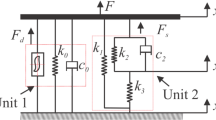Abstract
This paper presents ride comfort and road holding analysis of passive and semi-active suspension system using quarter car model. Semi-active suspension system with magnetorheological (MR) damper was modeled as non-parametric model-based magnetic flux density in the fluid flow gap. The skyhook control strategy was used to analyze semi-active control performance. The simulation of passive and semi-active suspension system was carried out under random road profile for different velocities. The result shows that semi-active suspension has significant improvement in terms of ride comfort and road holding of vehicle than passive suspension system. Experimental studies have been conducted to characterize MR damper and a good match is observed between results with simulation results obtained using non-parametric model.















Similar content being viewed by others
References
Liu Y, Waters TP, Brennan MJ (2005) ) A comparison of semi-active damping control strategies for vibration isolation of harmonic disturbances. J Sound Vib 280(1):21–39
Harris CM (1987) Shock and vibration handbook. McGraw-Hill, New York
Butz T, Von Stryk O (2002) Modelling and simulation of electro-and magnetorheological fluid dampers. ZAMM 82(1):3
Shivaram AC, Gangadharan KV (2007) Statistical modelling of a magneto-rheological fluid damper using the design of experiments approach. Smart Mater Struct 16(4):1310
Chooi WW, Oyadiji SO (2008) Design, modelling and testing of magnetorheological (MR) dampers using analytical flow solutions. Comput Struct 86(3):473–482
Costa E, Branco PJ (2009) Continuum electro mechanics of a magnetorheological damper including the friction force effects between the MR fluid and device walls Analytical modelling and experimental validation. Sens Actuators 155(1):82–88
Avinash B, Sundar SS, Gangadharan KV (2014) Experimental study of damping characteristics of air, silicon oil, magneto rheological fluid on twin tube damper. Int Conf Adv Manuf Mater Eng NITK 5:2258–2262
Boada MJL, Calvo JA, Boada BL, Diaz V (2011) Modeling of a magnetorheological damper by recursive lazy learning. Int J Non-Linear Mech 46(3):479–485
Metered H, Bonello P, Oyadiji SO (2010) The experimental identification of magnetorheological dampers and evaluation of their controllers. Mech Syst Signal Process 24(4):976–994
Ekkachai K, Nilkhamhang I (2012) MR damper identification using EHM-based feed forward neural network. In SICE Annual Conference Proceedings of IEEE, Akita University, 1138–1143
Du H, Yim Sze K, Lam J (2005) Semi-active H∞ control of vehicle suspension with magneto-rheological dampers. J Sound Vib 283(3):981–996
Ambhore NH, Pangavhane DR, Hivarale SD (2013) A study of some nonparametric model of magnetorheological fluid damper for vibration control. Int J Curr Eng Technol 3:388–392
Xubin Song, Ahmadian Mehdi, Southward Steve C (2005) Modelling MR dampers with application of nonparametric approach. J Intell Mater Syst Struct 16(5):421–432
Hemanth K, Ganesha A, Kumar Hemantha, Gangadharan KV (2014) Analysis of MR damper based on finite element approach. Appl Mech Mater 592:2006–2010
Gołdasz J, Sapinski B (2011) Modelling of magnetorheological mounts in various operation modes. acta mechanica et automatica, 5, 29–40
Parlak Z, Engin T, Call I (2012) Optimal design of MR damper via finite element analyses of fluid dynamic and magnetic field. Mechatronics 22(6):890–903
Guan X, Guo P, Ou J (2009) Multi-objective optimization of magnetorheological fluid dampers. Eng Mech 26:30–35
Rao M, Ram T, Purushottam A (2010) Analysis of passive and semi active controlled suspension systems for ride comfort in an omnibus passing over a speed bump. Int J Res Rev Appl Sci 5(1):7–17
Alexandru C, Alexandru P (2011) A comparative analysis between the vehicles passive and active suspensions. Int J Mech 5(4):371–378
Abdolvahab A, Chavan US, Phvithran DS (2012) Simulation and analysis of passive and active suspension system using quarter car model for non uniform road profile. Int J Eng Res Appl 2(5):900–906
Chen Y (2009) Skyhook surface sliding mode control on semi-active vehicle suspension system for ride comfort enhancement. Engineering 1(01):23
Gopala Rao LVV, Narayanan S (2009) Sky-hook control of nonlinear quarter car model traversing rough road matching performance of LQR control. J Sound Vib 323:515–529
Yoshimura T, Kume A, Kurimoto M, Hino J (2001) Construction of an active suspension system of a quarter car model using the concept of sliding mode control. J Sound Vib 239(2):187–199
Prabakar RS, Sujatha C, Narayanan S (2013) Response of a quarter car model with optimal magnetorheological damper parameters. J Sound Vib 332(9):2191–2206
Sireteanu T, Stoia N (2003) Damping optimization of passive and semi-active vehicle suspension by numerical simulation. Proc Romanian Acad 4(2):121–127
Kurczyk S, Pawełczyk M (2013) Fuzzy control for semi-active vehicle suspension. Low frequency noise. Vibration and Active Control 32(3):217–226
Guo Zhang (2004) Optimal placement of MR dampers for structural control using identification crossover genetic algorithm. Low Freq Noise Vibration Active Control 23(3):167–178
Gangrou Peng (2011) Development of MR damper for motorcycle steering. ME thesis, University of Wollongong
Patil K S, Jagtap V, Jadhav S, Bhosale A, Kedar B (2013) performance evaluation of active suspension for passenger cars using MATLAB. In Second National Conference on Recent Developments in Mechanical Engineering. IOSR J Mech Civil Eng 06–14
He L, Qin G, Zhang Y, Chen L (2008) Non-stationary random vibration analysis of vehicle with fractional damping. Int Conf Intell Comput Technol Auto 2:150–157
Tyan F, Hong YF, Tu SH, Jeng WS (2009) Generation of random road profiles. J Adv Eng 4(2):1373–1378
Barbosa RS (2011) Vehicle dynamic response due to pavement roughness. Journal Brazilian Soc Mech Sci Eng 33(3):302–307
Acknowledgments
The authors acknowledge the funding support from Department of Science and Technology (DST): No.SB/FTP/ETA-0071/2013 and also acknowledge SOLVE Lab: The Virtual Lab @ NITK (http://www.solve.nitk.ac.in) and Centre for System Design (CSD): A Centre of excellence at NITK-Surathkal for providing experimental facility.
Author information
Authors and Affiliations
Corresponding author
Additional information
Technical Editor: Kátia Lucchesi Cavalca Dedini.
Rights and permissions
About this article
Cite this article
Hemanth, K., Kumar, H. & Gangadharan, K.V. Vertical dynamic analysis of a quarter car suspension system with MR damper. J Braz. Soc. Mech. Sci. Eng. 39, 41–51 (2017). https://doi.org/10.1007/s40430-015-0481-7
Received:
Accepted:
Published:
Issue Date:
DOI: https://doi.org/10.1007/s40430-015-0481-7




